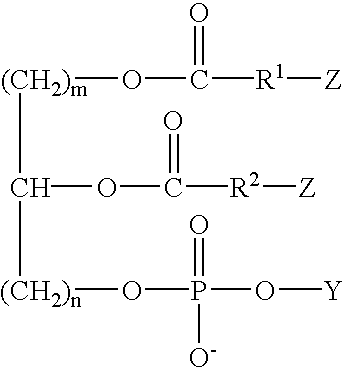Modular cytomimetic biomaterials, transport studies, preparation and utilization thereof
a technology of cytomimetic biomaterials and transport studies, applied in the field of module cytomimetic biomaterials, transport studies, preparation and utilization thereof, can solve the problems of platelet adhesion, activation and aggregation, lack of suitable synthetic materials,
- Summary
- Abstract
- Description
- Claims
- Application Information
AI Technical Summary
Problems solved by technology
Method used
Image
Examples
example 1
Sources of Materials
Materials. AAPD (2,2'-azobis(2-methylpropionamidine) dihydrochloride), DTBC (2,6-di-tert-butyl-p-cresol), 1.12-dodecanediol, pyridine, DMAP (4-(NDN-dimethylamino) pyridine), DCC (dicyclohexylcarbodiimide), succinic anhydride, MTEM [2-(methylthio)ethyl methacrylate], and PDC (pyridinium dichromate) were obtained from Aldrich and used as received. 2-Hydroxyethyl acrylate (Aldrich) was vacuum distilled. Dioctadecylamine (Fluka) was used as received. 1-Palmitoyl-2-hydroxy-sn-glycero-3-phosphocholine was obtained from Avanti Polar Lipids and used as received. THF, toluene, dichloromethane and pyridine were obtained from Fisher and dried over 4 .ANG. molecular sieves. Acryloyl chloride was obtained from Aldrich and vacuum distilled prior to use. Chloroform (Aldrich) was washed with water, dried over CaCl.sub.2, distilled, and stored over 3 .ANG. molecular sieves. AIBN (2,2'-azobisisobutyronitrile) (Aldrich) was recrystallized from methanol. The resin AG 501-X8 was obta...
example 2
Methods of Synthesis
(a) Synthesis of 12-(Acryloyloxy)-1-dodecanol (1).
The synthesis was carried out essentially as described in Sells et al. (1994) Macromolecules 27:226.
1,12-Dodecanediol (50.0 g, 0.247 mol) was dissolved in 500 ml TBF with gentle heating. Pyridine (8.0 ml, 0.100 mol) was added and the solution was cooled to room temperature. One crystal of 2,6-di-tert-butyl-p-cresol was added. Acryloyl chloride (6.0 ml, 0.074 mol) was dissolved in 40 ml TBF and slowly added dropwise. After 24 hours, the mixture was filtered to remove pyridine hydrochloride. The filtrate was rotoevaporated to give a white solid, which was taken up in 200 ml CHCl.sub.3 and placed in an ice bath for one hour. The mixture was filtered to remove unreacted diol and the filtrate was dried over Na.sub.2 SO.sub.4. The solvent was removed in vacuo to give a residue that was purified by flash chromatography on silica gel (CHCl.sub.3 / MeOH, 95 / 5). The product was a clear oil (1) [yield 14.90 g (79%); .sup.1 H ...
example 3
Preparation of Silanized Glass
(i) Materials
Microscope borosilicate glass coverslips (S / P Cover Glass, 24.times.40.times.0.25 mm, no. 2 thickness) were purchased from Baxter Scientific, Inc. Multi-Terge.TM., a powerful high-pH chelating detergent, was purchased from EM Diagnostic Systems, Inc. (Gibbstown, N.J.). All other chemicals and solvents (HPLC grade) were purchased from Aldrich. Hydrated CHCl.sub.3 was prepared and stored in a clean screw-cap amber bottle by vigorously shaking 25 ml CHCl.sub.3 (1% ethanol-stabilized) with 10 .mu.l deionized water. A 63 mM octadecyltrichlorosilate (OTS) stock solution in dry CCl.sub.4 was prepared under nitrogen by injecting 1.7 ml OTS (95%, stored in dessicator at room temperature) with a 3-ml polypropylene syringe through a 0.1 .mu.m PTFE syringe filter, directly into the commercial Suresea.TM. container of 100 ml anhydrous CCl.sub.4 (99+%, <0.005% water). The bottle was capped with a virgin rubber liner (Aldrich), closed with a bakelite scre...
PUM
| Property | Measurement | Unit |
|---|---|---|
| roughness | aaaaa | aaaaa |
| Tm | aaaaa | aaaaa |
| sizes | aaaaa | aaaaa |
Abstract
Description
Claims
Application Information
 Login to View More
Login to View More - R&D
- Intellectual Property
- Life Sciences
- Materials
- Tech Scout
- Unparalleled Data Quality
- Higher Quality Content
- 60% Fewer Hallucinations
Browse by: Latest US Patents, China's latest patents, Technical Efficacy Thesaurus, Application Domain, Technology Topic, Popular Technical Reports.
© 2025 PatSnap. All rights reserved.Legal|Privacy policy|Modern Slavery Act Transparency Statement|Sitemap|About US| Contact US: help@patsnap.com



